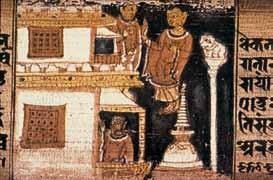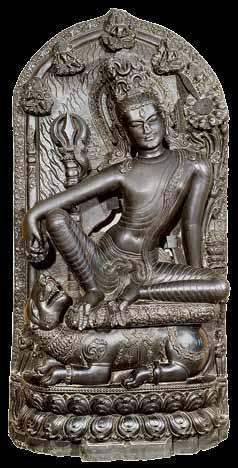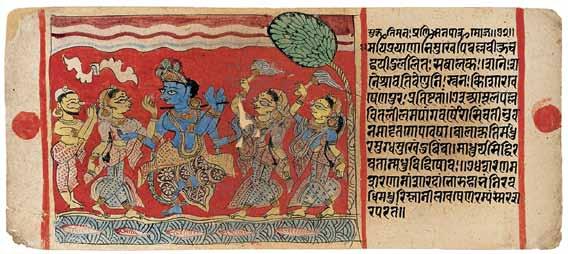
11 minute read
from palm-leaf to paper Manuscript Painting, 1100–1500
John Guy
Indian painting around the year 1100 CE, as far as we can judge from the few dated works that can be assigned securely to the period, was devoted almost exclusively to the illustration of Buddhist and Jain manuscripts. We know from pilgrim descriptions that the great Buddhist monasteries of eastern India were richly painted with murals devoted to sacred images, although none have survived. The murals in the Sumtsek chapel at Alchi monastery, Ladakh, dated to around 1200, are among the most extensive mural paintings of this period extant, providing insight into the richness of the medieval mural painting tradition (Fig. 8). 1 The great monasteries (mahaviharas) of northern India, from Kashmir to Bengal, undoubtedly had equally magnificent painted interiors, radiant with Mahayana Buddhist imagery. The multistoried libraries of these centers were renowned as treasure houses of learning and Buddhist knowledge, housing vast stores of both manuscripts and the finest paintings of the age (Fig. 9). The Jain temple also had its knowledge repository, the jnana bhandars, which over time assumed a critical role as the custodial preserver of Jain knowledge and religious art.
Advertisement
The overwhelming majority of Buddhist illustrated texts are devoted to the Ashasahasrika Prajnaparamita (Perfection of Wisdom in 8,000 Verses) and the Pancaraksa (Five Protective Goddesses). The mystic spells and charms (vidya) that comprise both collections came to be personified as female deities, their iconographic forms already codified by the twelfth century in the Sadhanamala (rosary/garland of invocations) and Nispannayogavali. 2 These profoundly influential texts gave voice to the Mahayanist preoccupation with compassion embodied in the cult of bodhisattvas and taras.
Buddhist artists—mostly monks, we can assume—produced a great corpus of illustrated palm-leaf texts in eastern India during the eleventh and twelfth centuries. They draw imagery from two prototypes—temple sculptures that embody the elaborate
Figure 8. Prajnaparamita, Sumtsek chapel, Alchi monastery, Ladakh. Mural painting on plaster, ca. 1200. Photograph by J. Poncar
iconographic schema developed in the parent texts (Fig. 10) and mural paintings of which almost nothing survives from this period. In both instances, the manuscript artists had to miniaturize radically, which they achieved with consummate skill. The sophisticated linear and chromatic complexity of the Pala painting style is evident by the date of the oldest survivors, two editions of the Ashasahasrika Prajnaparamita manuscript produced in the
Figure 9. Monks in a monastery with multistoried hall, stupa, and lion-stambha. Painting on palm-leaf manuscript, ca. 12th century. Nepal. National Archives, Kathmandu

eleventh century during the fifth and sixth year of the reign of Mahipala I (the later one at Nalanda monastery). 3 A century or so later, an artist produced manuscript paintings of the unsurpassed quality seen in the Vredenberg manuscript commissioned by the donor Udaya-simha in the thirty-sixth year of Ramapala’s reign (first quarter of the twelfth century, a near contemporary of the Mahavihara Master manuscript (Nos. 1, 2). 4 The place of production is not recorded for either work, but for the Vredenberg manuscript, in which the compositions are dominated by large-scale figures in compact settings, the monastic scriptoria at Nalanda or Vikramasila are real possibilities. Three of the only six provenanced Pala manuscripts are assigned to Nalanda, suggesting that this was a major center for the production of illustrated Buddhist manuscripts, along with Vikramasila and Uddandapura. 5 The Mahavihara Master manuscript paintings, with their highly elaborated architectural and lush treescape settings, more likely are products of one of the great monastery scriptoria of Bengal.
No Buddhist paintings of this period carry an artist’s signature or a scribal attribution. Texts were written first, with space reserved for the artist to insert the painting, the latter routinely overlapping the script at the margins. Sometimes, the scribe wrote instructions for the painter, confirming their separate roles. Literate monks working in monastic scriptoria must have been responsible for both activities. In many instances, the iconography does not strictly conform to the iconographic prescriptions, suggesting that some painters were less than fully conversant with the authority texts. That scribes are often named in colophons, and painters never, indicates a hierarchy of activities that placed the learned skill of writing above that of picture making.
The Buddhist artists display an astute sensitivity of line and form, and they work in a confident if sometimes summary manner that suggests long familiarity with the conventions of this style. Figures are rendered in flat washes of intense color, with limited tonal modeling and assured silhouetting. A hierarchic ordering of deity and devotee is observed. Over a period of two centuries, the artists of this era redefined the possibilities of miniature painting, creating miniaturizations of large-scale mural painting into a format averaging 2 by 3 inches (5.1 x 7.6 cm). By the close of the twelfth century, Buddhist monastic painting had come to an abrupt end as the monasteries of eastern India fell victim to a series of devastating campaigns by the Sultanates of Bengal.
Painted narratives on Jain wooden manuscript covers ( pothi) count among the earliest surviving examples of Indian manuscript art. The oldest datable painted manuscript cover can be assigned securely to the first half of the twelfth century, on the basis of its association with a revered Jain Svetambara guru, Sri Jinadatta Suri, who is depicted discoursing in the Discussion Hall (Vyakyana Sabha). 6 This renowned teacher was elevated to the rank of Acharya in 1112 and died in 1154, and thus, this manuscript reasonably can be assigned to the period between those dates. Another Jain painted cover depicts an important contemporary event, a theological debate held in 1124 at the court of the Solanki dynasty ruler Siddharaja Jayasimha in Patan, Gujarat. The two leading Jain theologians of the day, the Digambara Kumuda Chandra and the Svetambara Vadi Devasuri, engaged in an extended debate in which the celebrated Svetambara monk prevailed. 7 The last scene shows the defeated Digambara challenger banished from the palace, whereupon he is attacked by a cobra, no doubt to be understood as divine retribution for his misguided beliefs. 8 This painting, which may be datable to within a few years of the event depicted, demonstrates the advanced state of the Jain pictorial style, with its strong use of linear silhouette and flat washes of intense color and inclusion of scene dividers.
Manuscript painting in the succeeding two centuries was largely the domain of the artists of western India, serving the needs of the Jain community and the occasional Hindu patron, as seen in illustrated editions of popular Hindu stories such as the Balagopalastuti (Praise of the Youthful Krishna), a devotional work of prose recounting the exploits of the young Krishna (Fig. 11). 9
The style, best described as Western Indian, is archaic and conservative, echoing ancient compositions (Fig. 12). It is characterized by areas of flat color of saturated intensity, heightened by
the use of black linear outline. The painting style of the human figure is particularly distinctive. The silhouette is angular and sharp; the figure has a slender waist and swelling chest; the nose and chin are pointed; and the face in three-quarter profile has a projecting almond-shaped eye that appears alert and worldly. This eye convention became a hallmark of such paintings, and of figurative designs in other mediums, such as painted cotton textiles of the late fourteenth and fifteenth centuries. 10 Manuscripts of this and later periods retain several anachronistic features, the most obvious of which is the long and narrow horizontal format of the palm-leaf, which persisted long after the widespread availability of paper. It is perhaps significant that the oldest dated paintings on paper in India appear in a Svetambara Jain manuscript edition of the Kalakacaryakatha, dated 1366 and produced in Yoginipur (Delhi). 11 Yoginipur had become an important center in the thirteenth century for Jains, who were drawn there no doubt by the commercial opportunities offered by the Sultanate rulers of Tughlaq and Lodi Delhi. 12

Figure 10. Bodhisattva Simhanada Lokesvara. Reportedly from the site of Sultanganj monastery, Bhagalpur District, Bihar, late 11th–12th century. Black basalt. Birmingham Museums and Art Gallery, Gift of Samuel Thornton, 1864 (1885A1472.1)
Western Indian painting underwent a number of changes during the first half of the fifteenth century. Artists responded enthusiastically to the availability of new colors and presumably so too did the clients who had to pay for these expensive ingredients. Lapis lazuli, which produced the most luminous ultramarine, became more widely available, and also a new crimson, probably produced from a native lac (a resin secreted by insects). This brilliant red quickly displaced blue as the preferred background color, as is demonstrated in a superb Kalpasutra painted at Mandu in 1439. 13 Gold and silver were also introduced into the artist’s palette and became fashionable materials for the enrichment of commissioned manuscripts, often to the detriment of pictorial clarity; even the most finely executed painting was often rendered flat and lifeless by the indiscriminate application of gold or silver overpainting.
These changes were largely of emphasis and embellishment rather than fundamental shifts in style. They were partly a result of the growing commercial contacts between northern India and the Islamic cultures of Mamluk Egypt and Timurid Iran. The circulation of illustrated Islamic manuscripts and their richly tooled and gilded bindings—principally Korans but also editions of the Shahnama and other literary works—together with luxury goods such as Timurid carpets, textiles, and metalware, contributed to the enriching of the visual landscape of the Indian subcontinent.
By around 1400, paper folios had gained more height to accommodate greater pictorial decoration, no doubt inspired by Islamic codex books in circulation through the Sultanate courts. The enhanced scale also allowed artists to develop the border designs, some of which display direct Iranian influence, echoing decorative elements such as the flowering vine and tree that had become so prevalent in fifteenth-century Sultanate architecture and textile design. Other centers also witnessed the Jain patronage of finely painted manuscripts, a superb Kalpasutra painted at Mandu in 1439, for example. 14 Two dated editions of the Kalpasutra, produced in Jainpur in 1465, and the so-called Devasano Pado Kalpasutra and Kalakacharyakatha produced in Ahmedabad about 1475 (Nos. 5, 6), represent important stages in the progression beyond conventional western Indian style with the gradual integration of Indian and Iranian elements in the early sixteenth century. Both display a growing awareness in Jain painting studio circles of the manuscript art of Timurid Iran. It is thus apparent that artists working for Jain clients had access to Islamic court culture, as can be seen most vividly in the frequent borrowings
of decorative schema—interlaced vine border cartouches, for example—and in a newfound confidence to add elaborate marginal decor that occupies a significant area of the page. Placement of the picture components also became more varied, and text size was reduced and often given a decorative treatment in gold on red or blue ground. The use of conspicuously expensive materials, notably gold, silver, and lapiz lazuli, is a prevailing feature of this final phase of the Western Indian style.
These innovations in Western Indian painting were not confined to Jain and Hindu manuscripts. A recently discovered edition of the Shahnama, the Persian Book of Kings by Firdawsi, datable to around 1450, establishes a Sultanate-period Islamic manuscript firmly in the Western Indian style (Nos. 5, 6). 15 Its paintings observe the conventions of Central Asian dress of the Sahi nobility, no doubt following imported Iranian editions of the Shahnama as their model, while using the rich palette, including a brilliant red ground, of the Indian school. 16 Although this manuscript is in a codex form and draws heavily on its Iranian model, the pictures are landscape format, sharing the page with text in various configurations. Conventions for rocks and clouds are of Iranian derivation, which seems to be filtered through a Jainesque prism, fused with other motifs, such as figure types and trees, of Western Indian style.
Over the course of the thirteenth to fifteenth century, the Muslim Sultanates had established power across northern India, from Gujarat to Bengal. Their center in Delhi was to have the most lasting importance for the history of Indian painting; there, a viable alternative to the western Indian style was created. Together with the highly influential school of Hindu devotional manuscript painting that emerged subsequently in the Delhi-Agra region in the early to mid-sixteenth century—represented by the Caurapancasika and the Palam and Isarda Bhagavata Purana manuscripts—this location became the new epicenter of artistic innovation.
By 1500, painting styles in India were on the cusp of a revolution, triggered by the Sultanate kingdoms of northern India, which maintained active links with the courts of Iran, Egypt, and Afghanistan. The workshops of the Sultanate courts of Delhi and Bengal provided imported Iranian models for their artists but were obliged to largely recruit Indian artists trained in the Hindu and Jain traditions, as were their Mughal successors. 17 The fusion of these Indian and imported painting styles was the catalyst for the radical developments that mark the first half of the sixteenth century and beyond.
Figure 11. Krishna playing flute and dancing to the delight of the gopis; folio from a Balagopalastuti manuscript. Gujarat, ca. 1450. Opaque watercolor on paper. Museum of Fine Arts, Boston, Denman Waldo Ross Collection (30.106)

Figure 12. Miracle of Sravasti. Relief sculpture from the gateway of Stupa No. 1, Sanchi, India. Early 1st century CE











